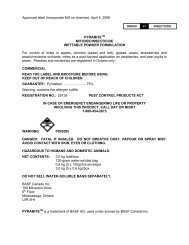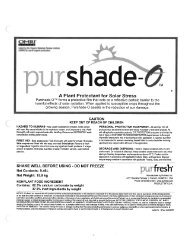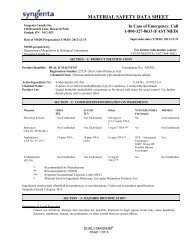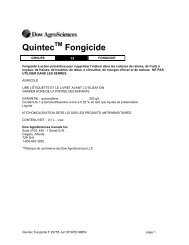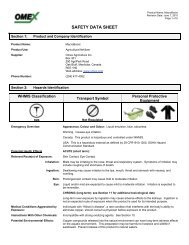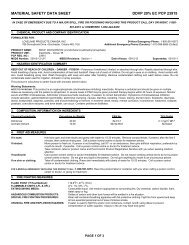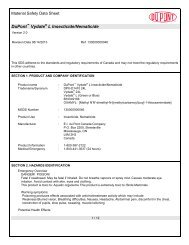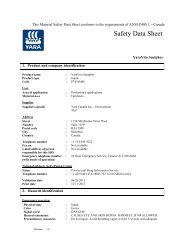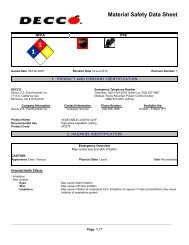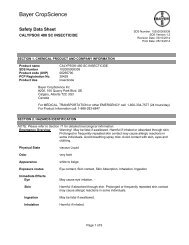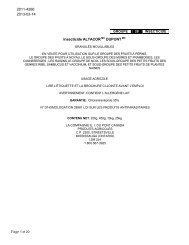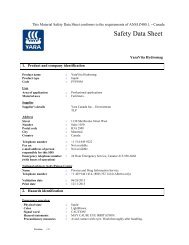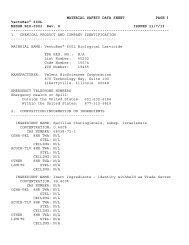Hydrochloric Acid msds english.pdf - Bartlett.ca
Hydrochloric Acid msds english.pdf - Bartlett.ca
Hydrochloric Acid msds english.pdf - Bartlett.ca
You also want an ePaper? Increase the reach of your titles
YUMPU automatically turns print PDFs into web optimized ePapers that Google loves.
<strong>Hydrochloric</strong> <strong>Acid</strong>, 30 - 40 %WHMIS Number : 00060172Page 6 of 9Brenntag Canada Inc.Date of Revision: 2011 January 10Under Fire Conditions:Hazardous Polymerization:Conditions to Avoid:Materials to Avoid:Not flammable. When heated, hydrogen chloride gas is liberated.Will not occur.High temperatures, sparks, open flames and all other sources of ignition. Avoid contact with water.Hygroscopic.Strong oxidizers. Lewis or mineral acids. Sulphuric <strong>Acid</strong>. Ammonia. Strong bases. Combustibles.Amines. Alkanol amines. Organic materials. Reducing agents. Nylon. Carbonates. Cyanides. Sulfides.Carbides. Epoxides. Aldehydes. Phosphides, borides, silicides. Attacks some types of rubber, plasticsand coatings.Finely divided metals. Zinc and its alloys. Brass. Bronze. Galvanized iron. Metals. Alkali metals and theirhydroxides. Metal Oxides. Metal Acetylides. Corrosive to iron, steel, copper and their alloys. Hydrogengas may be produced on prolonged contact with metals such as aluminum, tin, lead and zinc.Formaldehyde: Reaction with hydrochloric acid may form bis-chloromethyl ether. Bis-Chloromethyl etheris a suspected human <strong>ca</strong>rcinogen according to ACGIH (Ameri<strong>ca</strong>n Conference of Government IndustrialHygienists) and <strong>ca</strong>rcinogenic to humans according to IARC (International Agency for Research onCancer).Decomposition or CombustionProducts:Thermal decomposition products are toxic and may include chlorine and hydrogen chloride.11. TOXICOLOGICAL INFORMATIONTOXICOLOGICAL DATA:SUBSTANCE LD50 (Oral, Rat) LD50 (Dermal, Rabbit) LC50 (Inhalation, Rat, 4h)<strong>Hydrochloric</strong> <strong>Acid</strong> 700 - 1 300 mg/kg (3) > 5 010 mg/kg (3) 1 308 - 1 562 ppm (1,3)Carcinogenicity Data:Reproductive Data:Mutagenicity Data:Teratogenicity Data:Respiratory / Skin SensitizationData:Synergistic Materials:Other Studies Relevant toMaterial:The ingredient(s) of this product is (are) not classed as <strong>ca</strong>rcinogenic by ACGIH, IARC, OSHA or NTP.No adverse reproductive effects are anticipated.<strong>Hydrochloric</strong> <strong>Acid</strong> has demonstrated mutagenic activity in bacterial assay system. See "Other StudiesRelevant to Material".<strong>Hydrochloric</strong> <strong>Acid</strong>: may <strong>ca</strong>use teratogenic / embryotoxic effects based on studies in laboratory animals,but only at high, generally toxic doses. (3)None known.Formaldehyde: Reaction with hydrochloric acid may form bis-chloromethyl ether. Bis-Chloromethyl etheris a suspected human <strong>ca</strong>rcinogen according to ACGIH (Ameri<strong>ca</strong>n Conference of Government IndustrialHygienists) and <strong>ca</strong>rcinogenic to humans according to IARC (International Agency for Research onCancer).Appli<strong>ca</strong>tion of a 1 % <strong>Hydrochloric</strong> <strong>Acid</strong> solution to the eyes of rabbits for 20 seconds <strong>ca</strong>used corneals<strong>ca</strong>rring. Other studies have reported that appli<strong>ca</strong>tion of 5 mg for 30 seconds <strong>ca</strong>used mild irritation andthat appli<strong>ca</strong>tion of a 5 % solution <strong>ca</strong>used minimal irritation. Corrosive burns resulted when 0.5 ml of a 17% concentrated solution was applied to rabbit skin for 4 hours. (4)Mutagenic effects have been reported in one bacterial test, in three insect tests and in one in vitromammalian cell test (Hamster lung cells). <strong>Hydrochloric</strong> <strong>Acid</strong> tested negative in another in vitromammalian cell test (Syrian Hamster embryo cells). (4)Epidemiologi<strong>ca</strong>l studies, which studied <strong>Hydrochloric</strong> <strong>Acid</strong> and risk of developing <strong>ca</strong>ncer, have observedexcess lung <strong>ca</strong>ncers in workers exposed to <strong>Hydrochloric</strong> <strong>Acid</strong>. Increased risk of oat-cell <strong>ca</strong>rcinoma wasalso observed in workers exposed to <strong>Hydrochloric</strong> <strong>Acid</strong>. Male rats exposed to 10 ppm <strong>Hydrochloric</strong> <strong>Acid</strong>vapour / mists for 6 hours/day, 5 days/week, for their lifetimes showed no <strong>ca</strong>rcinogenic or chronic toxiceffects. (4)Female rats were exposed to 450 mg/m³ for 1 hour either prior to mating or on day 9 of pregnancy.Developmental effects were observed in the offspring. However, this exposure <strong>ca</strong>used toxic effects,including mortality, to mothers. (4)12. ECOLOGICAL INFORMATION



